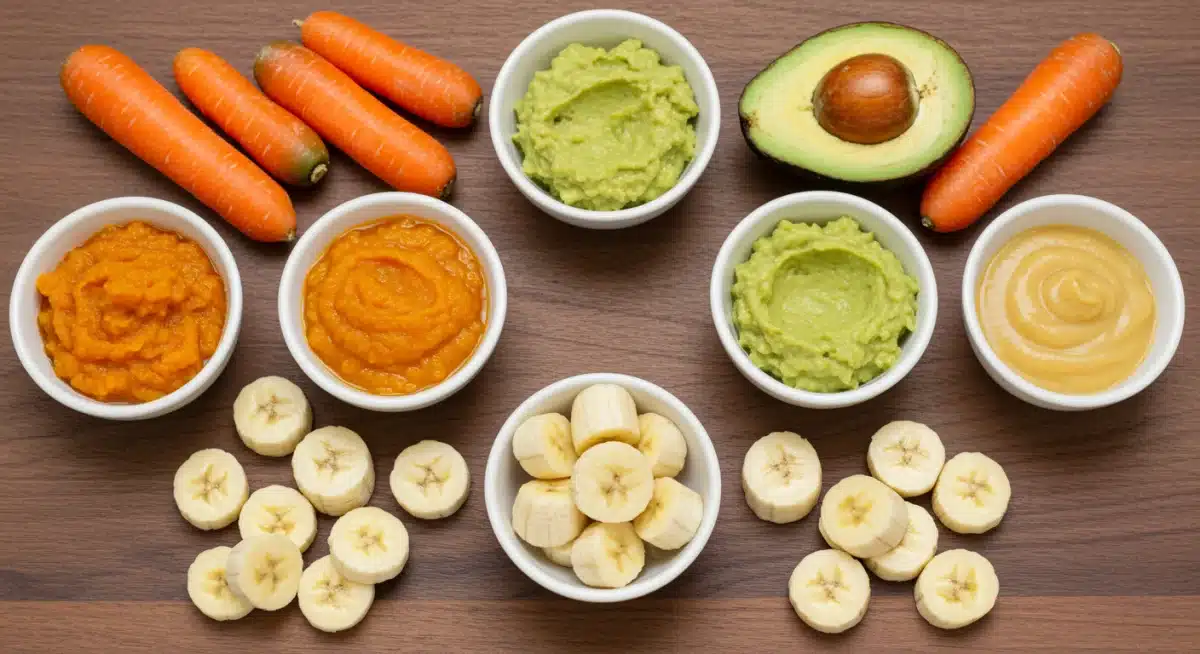Baby’s First Foods: 2025 Guide to Introducing Solids Safely

Advertisement
Introducing solid foods to a baby is a crucial developmental step, and this 2025 guide offers parents reliable, current strategies for safely and effectively transitioning infants to solids, ensuring nutritional adequacy and fostering healthy eating habits.
Embarking on the journey of introducing baby’s first foods is an exciting and sometimes daunting milestone for new parents. As we navigate 2025, understanding the latest recommendations and best practices is crucial for ensuring your little one’s healthy development and a positive experience with solids. This comprehensive guide aims to equip you with the knowledge and confidence needed to introduce solids safely and effectively, laying a strong foundation for your baby’s nutritional future.
Advertisement
Understanding Readiness: When to Start Solids
Deciding when to introduce solids is less about a specific age and more about developmental readiness. While many sources suggest around six months, observing your baby’s individual cues is paramount. Starting too early can pose risks, such as choking or digestive issues, while delaying too long might lead to nutritional deficiencies or difficulties accepting new textures.
The American Academy of Pediatrics (AAP) and other leading health organizations recommend introducing solids around six months of age, but always in conjunction with your baby showing clear signs of readiness. These signs indicate that your baby’s digestive system and motor skills are sufficiently developed to handle solid foods.
Key Readiness Cues to Look For
It’s important to differentiate between genuine readiness and mere curiosity. A baby reaching for your food doesn’t necessarily mean they are ready to eat it themselves. Look for a combination of these signs:
Advertisement
- Good Head and Neck Control: Your baby should be able to hold their head steady and sit upright with minimal support. This is crucial for safe swallowing.
- Loss of Tongue-Thrust Reflex: This reflex causes babies to push solids out of their mouths. It naturally diminishes around 4-6 months, allowing food to be swallowed.
- Opening Mouth When Food Approaches: This indicates anticipation and willingness to eat.
- Showing Interest in Food: Your baby might watch you eat, lean forward, or even try to grab food from your plate.
- Ability to Move Food from a Spoon to the Back of the Mouth: This shows coordination in swallowing.
Observing these cues carefully will help you determine the optimal time to begin introducing solids. Always consult with your pediatrician to confirm your baby’s readiness and discuss any specific concerns or medical conditions.
Ultimately, the timing of introducing solids is a personalized decision based on your baby’s developmental milestones rather than a strict calendar date. Prioritizing safety and readiness will ensure a smoother and more beneficial transition to solid foods.
First Foods to Offer: A Smart Start
Once your baby shows signs of readiness, the next step is choosing appropriate first foods. The goal is to introduce single-ingredient, easily digestible options to assess for allergies and allow your baby to adapt to new tastes and textures. The landscape of recommended first foods has evolved, moving away from strict cereal-only starts to a broader, more nutrient-dense approach.
Traditionally, rice cereal was the go-to first food. However, current recommendations emphasize a wider variety, including iron-fortified cereals, pureed fruits, vegetables, and even meats, recognizing the importance of diverse nutrients from the start. Iron is particularly vital as a baby’s iron stores from birth begin to deplete around six months.
Recommended First Food Categories
Focus on nutrient-rich foods that are easy to prepare and feed. Introducing these foods one at a time, with a few days between new foods, helps identify potential allergies or sensitivities.
- Iron-Fortified Cereals: Single-grain, iron-fortified cereals (like oat or rice) mixed with breast milk or formula are a classic start.
- Pureed Vegetables: Sweet potato, peas, green beans, carrots, and butternut squash are excellent choices. Start with smooth purees and gradually increase texture.
- Pureed Fruits: Apples, pears, bananas, and avocados are naturally sweet and easy to puree.
- Pureed Meats: Iron-rich meats like chicken, beef, or turkey, pureed to a smooth consistency, can be introduced early to boost iron intake.
- Legumes: Pureed lentils or beans can also offer protein and fiber.
Remember that breast milk or formula remains your baby’s primary source of nutrition during this transitional period. Solid foods are meant to complement, not replace, these vital feedings. Introducing a variety of flavors early on can also help foster a more adventurous palate as your child grows.
The selection of initial foods should prioritize nutritional value and ease of digestion, ensuring a positive first experience with solids. This diverse approach helps meet your baby’s growing needs while introducing them to a world of flavors.
Safe Feeding Practices: Minimizing Risks
Safety is paramount when introducing solids. Choking hazards, food allergies, and proper hygiene are critical considerations that parents must address. Establishing safe feeding practices from the outset ensures a positive and secure eating environment for your baby.
Always supervise your baby during meal times. Never leave an infant unattended with food. Being present allows you to respond immediately in case of choking or other issues. Proper positioning is also key: ensure your baby is sitting upright in a high chair with good head and neck support.
Essential Safety Guidelines
Beyond supervision, several practices can significantly reduce risks associated with feeding solids. Understanding these guidelines will help you create a safe and enjoyable mealtime experience.
- Choking Hazards: Avoid foods that are round, hard, sticky, or difficult to chew. Examples include whole grapes, nuts, popcorn, hot dogs, large chunks of meat, and hard candies. Cut foods into small, manageable pieces appropriate for your baby’s age and dexterity.
- Food Allergies: Introduce one new food at a time, waiting 3-5 days before introducing another. This allows you to identify any adverse reactions. Common allergens like peanuts, eggs, dairy, soy, wheat, fish, and shellfish can be introduced early, as per current recommendations, unless there’s a family history of severe allergies or your pediatrician advises otherwise.
- Hygiene: Always wash your hands and your baby’s hands before feeding. Use clean utensils and plates. Properly store and prepare foods to prevent bacterial contamination.
- Temperature: Ensure food is at a safe, lukewarm temperature. Test it on your wrist before offering it to your baby.
- Patience: Do not force your baby to eat. Respect their cues of fullness or disinterest. Mealtimes should be positive and stress-free.
By adhering to these safe feeding practices, you can confidently introduce solids to your baby, minimizing potential risks and fostering a healthy relationship with food. Always stay informed and consult with your pediatrician regarding any safety concerns.
Navigating Textures and Self-Feeding
As your baby grows, so too should the complexity of their foods. Transitioning from smooth purees to thicker textures and eventually finger foods is a natural progression that supports oral motor development and encourages self-feeding skills. This journey is about more than just nutrition; it’s about fostering independence and exploring new sensations.
Around 7-8 months, many babies are ready for mashed foods or soft, finely chopped pieces. This helps them learn to chew and move food around in their mouths. Introducing a variety of textures is crucial for preventing picky eating habits later on and for developing strong chewing muscles.

Encouraging Self-Feeding and Finger Foods
Self-feeding is a vital developmental milestone that enhances fine motor skills and hand-eye coordination. Offering appropriate finger foods allows your baby to explore food independently and learn to regulate their own intake.
- Soft Finger Foods: Start with soft, easily mashable foods cut into small, graspable pieces. Examples include cooked pasta, soft cooked vegetables (peas, carrots), small pieces of banana or avocado, and O-shaped cereals.
- Pincer Grasp Development: Around 8-9 months, babies typically develop the pincer grasp, allowing them to pick up small items between their thumb and forefinger. This is an ideal time to offer even smaller pieces of food.
- Patience and Mess: Self-feeding is messy, but it’s an important learning process. Provide a clean, safe environment where your baby can explore food without undue pressure.
- Role Modeling: Eat together as a family. Babies learn by observing, and seeing you enjoy a variety of foods can encourage them to do the same.
Gradually advancing textures and encouraging self-feeding are essential steps in your baby’s feeding journey. This approach not only supports their physical development but also cultivates a positive and independent relationship with food, making mealtimes an enjoyable experience for the whole family.
Allergens and Dietary Considerations in 2025
The guidelines for introducing common food allergens have significantly evolved in recent years. The once-common advice to delay introducing highly allergenic foods has been largely overturned by research suggesting that early introduction can actually reduce the risk of developing allergies. This proactive approach is a cornerstone of 2025 recommendations for infant feeding.
Current evidence, supported by organizations like the National Institute of Allergy and Infectious Diseases (NIAID), indicates that introducing common allergens like peanuts, eggs, cow’s milk products, soy, wheat, tree nuts, fish, and shellfish as early as 4-6 months of age, once other solid foods have been tolerated, can be beneficial. This is especially true for infants at high risk of developing food allergies.
Managing Allergen Introduction Safely
While early introduction is encouraged, it must be done carefully and strategically. Always consult your pediatrician before introducing allergens, particularly if your baby has severe eczema, a diagnosed food allergy, or a sibling with a peanut allergy.
- One Allergen at a Time: Introduce only one new common allergen every few days. This allows you to easily identify which food might be causing a reaction.
- Small Amounts First: Start with a very small amount of the allergenic food, gradually increasing the quantity over several days if no reaction occurs.
- Observe Closely: Watch for any signs of an allergic reaction, which can include hives, vomiting, diarrhea, swelling, or difficulty breathing. Seek immediate medical attention if a severe reaction occurs.
- Preparation: Ensure allergens are prepared in a safe, age-appropriate way. For example, for peanuts, use smooth peanut butter thinned with breast milk or water, not whole peanuts.
- Continued Exposure: Once an allergenic food is introduced and tolerated, continue offering it regularly (e.g., 2-3 times a week) to maintain tolerance.
Beyond allergens, other dietary considerations in 2025 include avoiding added sugars, excessive sodium, and honey for infants under one year due to the risk of botulism. A balanced approach to introducing a wide variety of foods, including allergens, is key to fostering a healthy and diverse diet for your baby.
Staying informed about the latest allergen introduction guidelines and working closely with your healthcare provider will empower you to navigate this aspect of feeding with confidence, ultimately promoting your baby’s long-term health.
Nutritional Needs and Balanced Diet Development
As your baby transitions to solid foods, their nutritional needs evolve beyond what breast milk or formula alone can provide. Developing a balanced diet is crucial for supporting their rapid growth, brain development, and overall health. The focus shifts from simply introducing foods to ensuring a diverse intake of essential vitamins and minerals.
Iron, zinc, and vitamin D are particularly important during this stage. While breast milk and formula provide initial stores, these often become insufficient around six months. Iron-fortified cereals, pureed meats, and certain vegetables can help replenish iron stores, essential for cognitive development and preventing anemia.

Building a Nutritious Plate
A balanced diet for infants involves offering a variety of foods from different food groups. This not only meets their nutritional requirements but also exposes them to a wide range of flavors and textures, encouraging healthy eating habits.
- Fruits and Vegetables: Offer a colorful array of pureed or soft-cooked fruits and vegetables. These provide essential vitamins, minerals, and fiber.
- Grains: Introduce iron-fortified infant cereals, whole-grain bread (softened or crust removed), and soft cooked pasta.
- Proteins: Include pureed or finely chopped meats (chicken, beef, fish), eggs, legumes (beans, lentils), and tofu. These are vital for growth and muscle development.
- Healthy Fats: Avocados, healthy oils (like olive or avocado oil in small amounts), and full-fat dairy (yogurt or cheese after 6-8 months, in moderation) provide crucial energy and support brain development.
- Water: Offer small sips of water with meals once solids are introduced, especially as they eat more solid foods.
Avoid processed foods, sugary drinks, and foods with excessive sodium. The goal is to provide nutrient-dense options that fuel your baby’s development. Remember that consistency and variety are key to establishing healthy eating patterns that will benefit your child for years to come.
By consciously building a diverse and nutritious diet, parents can ensure their baby receives all the necessary building blocks for optimal growth and development, fostering lifelong healthy eating habits.
Troubleshooting Common Feeding Challenges
Introducing solids isn’t always a smooth journey; many parents encounter various challenges, from picky eating to refusal of certain textures. Understanding these common hurdles and having strategies to overcome them can make the feeding process less stressful and more successful for both parent and baby.
One prevalent issue is food refusal. It’s common for babies to reject new foods initially. This doesn’t necessarily mean they dislike the food; it might simply be unfamiliar. Repeated exposure, sometimes up to 10-15 times, is often necessary before a baby accepts a new taste or texture.
Strategies for Overcoming Feeding Hurdles
Patience, persistence, and a positive attitude are your best tools when facing feeding challenges. Creating a supportive and enjoyable mealtime environment can significantly impact your baby’s willingness to try new foods.
- Picky Eating: Continue to offer a variety of foods, even those previously rejected. Present them in different forms or combinations. Avoid pressuring your baby to eat, as this can create negative associations with food.
- Texture Aversion: Gradually increase texture. If your baby only accepts purees, try slightly thicker purees, then mashed foods, and slowly introduce soft chunks. Mixing a preferred texture with a new one can also help.
- Distraction: Minimize distractions during mealtimes. Turn off screens and focus on the feeding process. Engage your baby in conversation about the food.
- Independent Feeding: Encourage self-feeding from an early age. When babies have control over what and how much they eat, they often become more adventurous.
- Consult a Professional: If you have significant concerns about your baby’s eating habits, growth, or potential allergies, consult your pediatrician or a registered dietitian. They can provide personalized advice and support.
Remember that feeding is a learning process for your baby, and there will be ups and downs. celebrate small victories and maintain a positive outlook. A relaxed and encouraging approach to mealtimes will foster a healthy and happy relationship with food for your child.
Addressing these common challenges with informed strategies will help create a positive feeding experience, ensuring your baby receives adequate nutrition while developing a healthy relationship with food.
The Role of Family Meals and Continued Development
Beyond the initial introduction of solids, the ongoing integration of your baby into family meals plays a crucial role in their dietary development and social learning. Sharing meals as a family provides a rich environment for babies to observe, learn, and develop positive eating habits that extend far beyond their first year.
By 12 months, most babies can eat a wide variety of foods, largely mirroring what the rest of the family consumes, albeit in appropriate textures and sizes. This transition is not just about nutrition; it’s about fostering a sense of belonging and teaching social cues associated with eating.
Fostering Healthy Eaters Through Family Meals
Family meal times are an excellent opportunity to model healthy eating behaviors and introduce your baby to a diverse diet. It’s a chance for them to see you enjoying various foods, which can make them more willing to try new things.
- Eat Together Regularly: Make family meals a regular occurrence. Even if it’s just a few times a week, the consistency is beneficial.
- Offer Similar Foods: Prepare meals that can be easily adapted for your baby. For example, if you’re having roasted vegetables, steam some extra for your baby and mash or cut them into small pieces.
- Model Good Habits: Let your baby see you eating a variety of fruits, vegetables, and whole grains. Avoid discussing food aversions or dislikes at the table.
- Engage in Conversation: Talk about the food, its colors, textures, and tastes. Make meal times enjoyable and interactive.
- Avoid Power Struggles: Let your baby decide how much they eat. Your role is to offer nutritious options; their role is to eat.
Continued development in feeding also involves transitioning from bottles to cups and encouraging greater independence with utensils. These steps further refine fine motor skills and prepare them for toddlerhood.
Integrating your baby into family meals and supporting their ongoing feeding development creates a solid foundation for lifelong healthy eating patterns and strengthens family bonds. This holistic approach ensures their nutritional needs are met while nurturing their social and developmental growth.
| Key Aspect | Brief Description |
|---|---|
| Readiness Cues | Look for good head control, loss of tongue-thrust reflex, and interest in food around 6 months. |
| First Food Choices | Start with single-ingredient, iron-fortified cereals, pureed fruits, vegetables, and meats. |
| Allergen Introduction | Introduce common allergens early and one at a time, under pediatrician guidance, to reduce allergy risk. |
| Safe Feeding | Supervise meals, avoid choking hazards, maintain hygiene, and respect baby’s fullness cues. |
Frequently Asked Questions About Baby’s First Foods
Your baby is ready for solids when they can hold their head up unassisted, sit upright with support, open their mouth for food, and show interest in what you’re eating. The tongue-thrust reflex, which pushes food out, should also have diminished, typically around six months of age.
Start with single-ingredient, iron-fortified cereals (like oat), pureed vegetables (sweet potato, peas), pureed fruits (banana, avocado), or pureed meats. Introduce one new food every 3-5 days to monitor for any allergic reactions and allow your baby to adapt to new tastes and textures.
Current recommendations suggest introducing common allergens like peanuts and eggs as early as 4-6 months, once other solids are tolerated. Early, consistent exposure can reduce allergy risk. Always consult your pediatrician, especially if your baby has a family history of severe allergies.
Avoid choking hazards such as whole grapes, nuts, popcorn, hot dogs, large chunks of meat, and hard candies. Do not give honey to babies under one year due to the risk of botulism. Also, limit added sugars, excessive sodium, and cow’s milk as a primary drink before 12 months.
Patience is key. Offer new foods repeatedly, even if initially rejected, sometimes up to 10-15 times. Avoid pressuring your baby to eat and keep mealtimes positive. Offer a variety of textures and involve your baby in family meals to encourage exploration and acceptance.
Conclusion
The journey of introducing baby’s first foods is a pivotal chapter in your child’s development, demanding both informed decisions and a nurturing approach. By understanding the signs of readiness, thoughtfully selecting initial foods, and adhering to safe feeding practices, parents can confidently navigate this exciting milestone. Embracing the latest recommendations for allergen introduction and focusing on a balanced, diverse diet will lay a robust foundation for your baby’s nutritional well-being and foster a positive relationship with food that lasts a lifetime. Remember to savor these moments, as they are not just about nourishment, but also about growth, discovery, and strengthening the bond with your little one.





